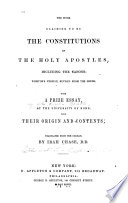 | Joseph Fletcher - 1847 - 652 pages
...provincial synods do not appear as a constant and regular institution, fixed to definite times, until the end of the second or the beginning of the third .century ; and it was in this case a peculiarity of one country, where particular local causes may have introduced... | |
 | Otto Krabbe - 1848 - 580 pages
...oppose the yiew of the Nazarenes. The rise* of the Clementine homilies may be placed, most probably, at the end of the second or the beginning of the third century ; where the Greek philosophy and speculative knowledge (y»-oj(7«s) began the contest with Christianity... | |
 | August Neander - 1850 - 546 pages
...assemblies, called together at stated seasons, these provincial synods do not fall under our notice before the end of the second or the beginning of the third century. And even then it is only as a peculiar practice of a single district, where local causes may have introduced... | |
 | August Neander - 1850 - 544 pages
...assemblies, called together at stated seasons, these provincial synods do not fall under our notice before the end of the second or the beginning of the third century. And even then it is only as a peculiar practice of a single district, where local causes may have introduced... | |
 | Charles Buck - 1851 - 888 pages
...Pentateuch alxo in quarto, in 1731, with Latin translations. He reckons these versions to have been made in the end of the second or the beginning of the third century. 21. UMK.KS, Danish. The first Danish Bible was' published by Peter Palladns, Olaiis Chrysoslom, John... | |
 | William Lindsay Alexander - 1799 - 208 pages
...to entitle him to say that they had been subjugated to Christ. From a statement such as this, made at the end of the second, or the beginning of the third century, we may justly infer that Christianity had been known in Britain at least in the early part of the second... | |
 | Joseph Fletcher - 1852 - 152 pages
...provincial synods do not appear as a constant and regular institution, fixed to definite times, until the end of the second, or the beginning of the third century ; and it was, in this case, a peculiarity of one country, where particular local causes may have introduced... | |
 | Edward Harold Browne (bp. of Winchester.) - 1853 - 686 pages
...is difficult to assign the exact date of these venerable canons ; but Bishop Beveridge places them at the end of the second, or the beginning of the third century. It being thus apparent, that, from the very first, excommunication was a regular part of the discipline... | |
 | Agénor comte de Gasparin - 1854 - 412 pages
...be pretended that the passage is any easier, from the apostolic Fathers to those who wrote towards the end of the second, or the beginning of the third century. Here, again, is an abyss to be crossed at any cost, for to fill it up is impossible. There lies here... | |
 | Robert Hall - 1855 - 512 pages
...comprehended the space of two centuries. Supposing the modern practice to have been first introduced towards the end of the second, or the beginning of the third century, which corresponds to the time at which it is distinctly noticed by Tertullian, the first writer who... | |
| |